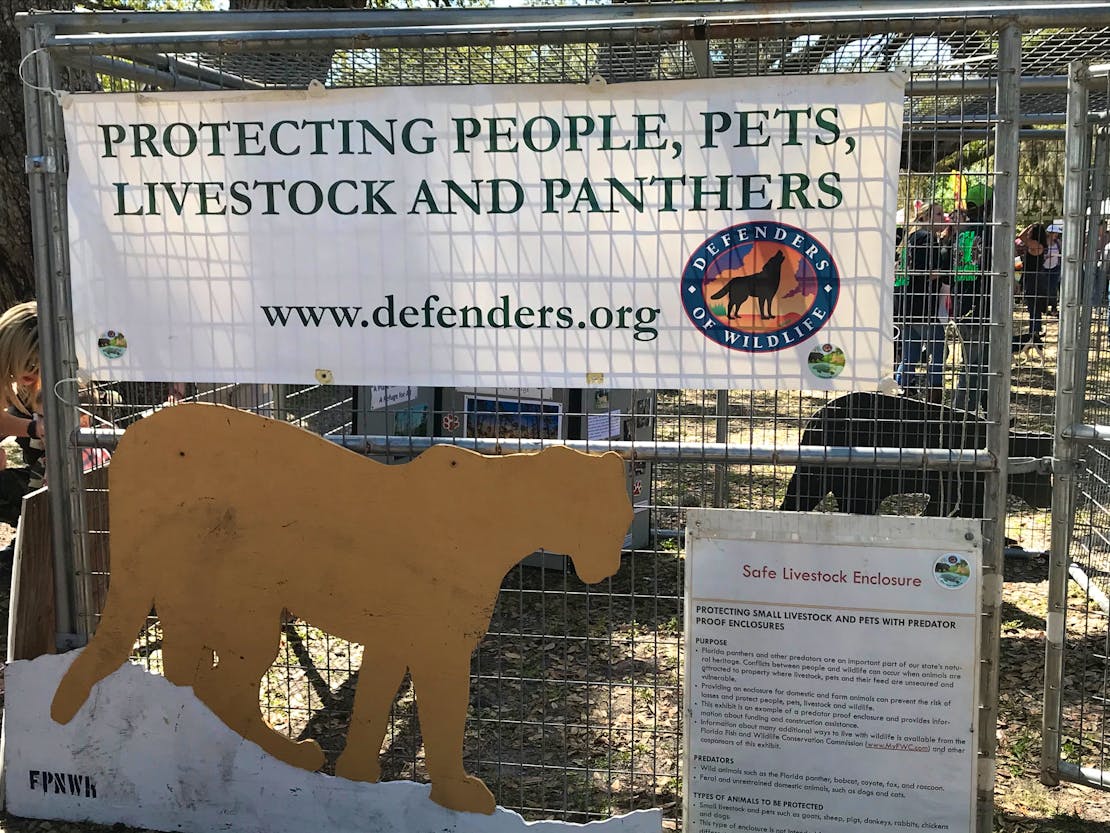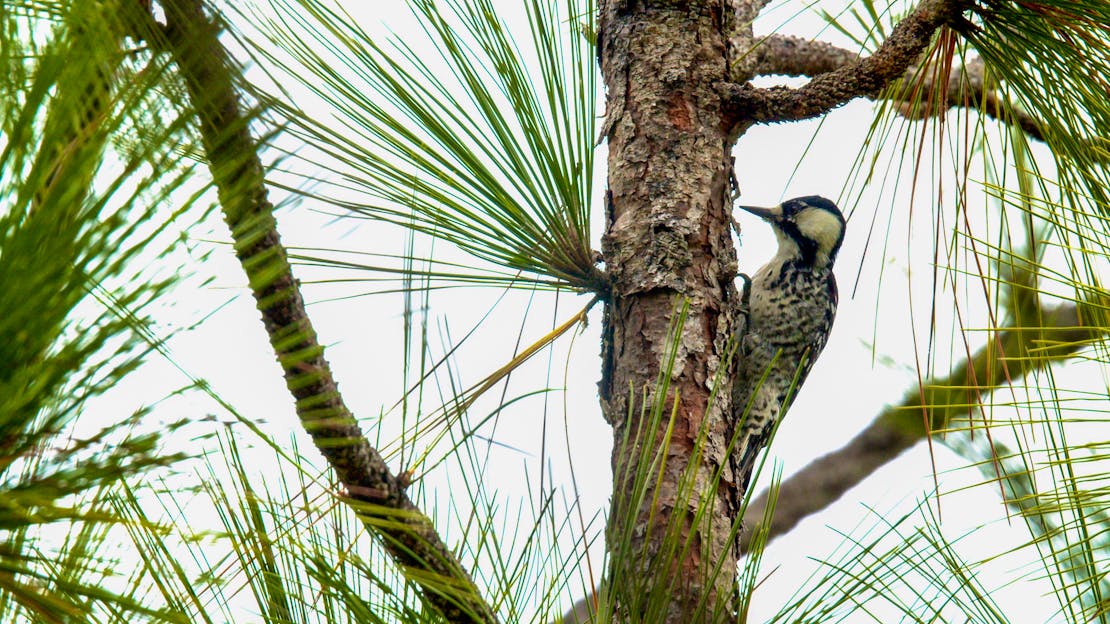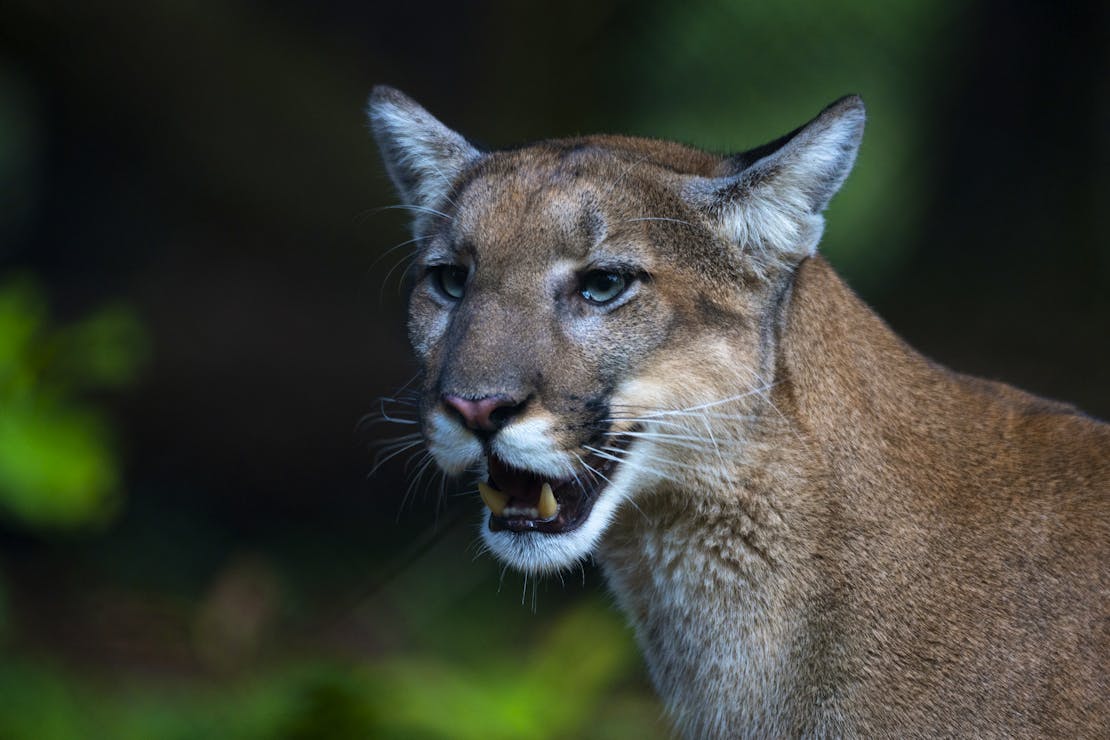The southeastern U.S. is one of the country's most biodiverse regions. It harbors coral reefs, sea turtles and marine mammals in coastal waters, and Red Wolves, gopher tortoises, bats, salamanders and Florida panthers ranging from the freshwater and terrestrial habitats of the Southern Appalachian Mountains to the Carolina and Gulf coasts, and down to the Everglades. But it’s also a region that faces many human impacts from high rates of development and busy roads, to increased hurricane activity and sea level rise caused by climate change. Defenders’ Southeast team had its hands full in 2022 and despite the challenges, we had some great successes. Here are a few highlights:
Reducing Human-Panther Conflict in Florida
In Florida, construction, development and the spread of urban areas is increasingly encroaching on wildlife habitat. This narrows the separation between human activities and wildlife habitats, which increases conflicts between people and predators such as the Florida panther. These conflicts often lead to local opposition to the presence of panthers, making conservation efforts for this endangered species even more difficult. For nearly two decades Defenders has been helping rural residents of Florida prevent conflicts with panthers and protect their pets and livestock through our predator-resistant enclosure program. In 2022, we provided funding and installation support for predator-resistant enclosures, gates and fencing to separate panthers from domestic animals, helping humans accept and support sharing the landscape with threatened predators as these big cats struggle to recover.
Protecting Wildlife from Road Construction
Another symptom of development and urban expansion is the construction of roads. Every year between 1-2 million wild animals die in the U.S. because of vehicle collisions. In Florida, Defenders has been battling proposals for new toll roads resulting from the Multi-Use Corridors of Regional Economic Significance (M-CORES) program. The M-CORES law, enacted by Governor Ron DeSantis (R-FL) on May 17, 2019, required Florida Department of Transportation (FDOT) to plan, develop and fund three new toll highways from the Everglades to the Florida-Georgia border. This massive highway expansion had the potential to irreversibly transform landscapes across Florida with more than 330 miles of new and expanded highways, feeder roads and associated sprawling residential and commercial development. It would have been the largest highway expansion in Florida since the creation of the Interstate System in the 1950s, destroying and fragmenting farms, ranches, forests and wildlife habitat for the endangered Florida panther and threatened manatee, as well as the black bear, gopher tortoise and many other species in some of the state’s most rural landscapes.
Our team served on the three regional task forces assembled to advise FDOT on environmental and economic considerations for these projects. Through our participation, we helped shape the final reports, which recommend that none of the three toll roads be built due to concerns about their impact on local communities, wildlife and the environment. Finally, after three years of overwhelming public opposition, in 2022 FDOT cancelled the third and final proposed toll road—a major win for wildlife in Florida.
Saving Manatees
In 2021, more than 1,100 Florida manatees died, largely due to starvation after pollution decimated seagrass beds on which the manatees fed. In 2022, at least 800 manatees died, adding to this death toll. Defenders has been working tirelessly to raise awareness of and urge action on the unprecedented mortality event. For example, we helped compel agencies to implement an emergency supplemental feeding trial to prevent another mass starvation event in the Indian River Lagoon where vast areas of seagrass have been lost. Defenders also helped secure increased state and federal funding for manatee rescue and rehabilitation efforts. We continue to press for a reduction in nutrient pollution—a threat responsible for fueling algal blooms that are not only killing the seagrass beds upon which manatees depend for survival, but also produce dangerous toxins. In 2022, Defenders and partners filed a lawsuit against the Environmental Protection Agency for failing to protect manatees and sea turtles from pollution that destroys seagrass. We are also advocating for the restoration of vital manatee habitat, including essential warm-water winter habitat like the Ocklawaha River. Additionally, we successfully sued U.S. Fish and Wildlife Service (FWS) this past year for failing to revise the Florida manatee’s decades-old critical habitat designation and negotiated a settlement agreement with the agency to revise the designation by September 2024.
Preserving the Environment Around Military Bases
The Northwest Florida Sentinel Landscape (NWFSL) is an area spanning roughly 7.7 million acres of the Florida Panhandle around Eglin Air Force Base; Tyndall Air Force Base; the Naval Air Stations Pensacola and Whiting Field; Naval Support Activity Panama City; and Hurburlt Field.
The area encompasses rural and agricultural lands, longleaf pine forests and the habitat of several threatened and endangered species. The Northwest Florida region provides habitat for 29 federally endangered and 20 threatened species. These include the red cockaded woodpecker, Eastern indigo snake, Panama City crayfish, frosted and reticulated flatwoods salamanders, mussels, Gulf sturgeon, beach mice, the snowy plover, and the loggerhead and green sea turtles. In particular, the Apalachicola River, with its floodplain and ravines, is one of North America’s most biologically diverse areas and is situated within the NWSL. Defenders played a key role in developing The Sentinel Landscapes Partnership, the body that designated Northwest Florida as a Sentinel Landscape in 2022. As the nonprofit coordinator for the NWFLS, Defenders is collaborating with more than four-dozen agencies and organizational partners to identify and implement conservation projects that will ensure natural and working lands thrive alongside the region’s military installations and ranges. This Sentinel Landscape designation is a significant victory for biodiversity in Florida as it will advance the acquisition of land for conservation, sustainable land management practices and restoration of essential wildlife habitat to recover populations of threatened species.
Our Hopes for 2023
The New Year is a time for resolutions and new plans, and Defenders of Wildlife’s southeastern team has several priorities for the forthcoming year. These include:
Supporting Red Wolf Recovery in North Carolina
In the early 1970s, because of declining Red Wolf populations, and fears for the species’ extinction, FWS began capturing Red Wolves for a captive breeding program. It proved to be a wise choice as in 1980 the Red Wolf was declared to be extinct in the wild. To restore the population, between 1987 and 1994, more than 60 captive-bred adult Red Wolves were released back into the wild in eastern North Carolina. By 2012, their numbers grew to an estimated 120 and the program appeared successful. However, in 2015 FWS stopped releasing Red Wolves and at the same time the population declined dramatically—many of the wolves were hit by vehicles and many were shot—until fewer than 20 remained. In 2021, thanks to our steadfast legal advocacy along with our partners, 11 more wolves were released. In addition, there was hopeful news in April this past year when a litter of pups was born, the first wild born litter since 2018. There are also plans for up to nine more wolf releases in 2023.
One of our major ambitions in 2023 is to work to reduce the conflict between humans and Red Wolves as we’ve done with Florida panthers. To this aim, we plan to launch our predator-resistant enclosure assistance program and open the application process to qualifying landowners. Along with the enclosures, we will provide a wildlife camera that will help to demonstrate the effectiveness of the enclosure in preventing conflicts between predators and livestock or pets. This will coincide with our first landowner workshop during which we will deploy our first set of non-lethal toolkits. By early spring we plan to have our new southeast coexistence website ready to launch, which will help facilitate implementation of this program and reach a broader audience with our coexistence message. Once implemented, we expect this program will help to protect Red Wolves and other predators from being killed out of fear or intolerance.
Expanding the Wildlife Refuge System in Southwest Florida
The National Wildlife Refuge System is the only U.S. network of public lands and waters dedicated to wildlife conservation. It’s vital for the protection of imperiled species, which rely on these lands for shelter and safety from escalating threats, such as climate change and development, that continue to drive habitat loss nationwide.
The Refuge System today protects hundreds of millions of acres of habitat essential to a diversity of plants and animals. Our wildlife refuges also provide countless recreational and educational opportunities and generate billions of dollars in sustainable economic revenue for local communities. With more than 60 million annual visitors, these protected places connect people with nature and serve as a gateway to our public lands. The system of public lands and waters protects our rich biological diversity and upholds the United States’ commitment to wildlife conservation.
Defenders of Wildlife has worked to defend and strengthen national wildlife refuges for decades, and in 2023 one of our major goals is to advance our campaign to expand the Refuge System in southwest Florida. With FWS and other partners, we are supporting the establishment of a conservation area in southwest Florida that would stretch from Florida Panther to Everglades Headwaters national wildlife refuges and conserve habitat and corridors for panthers and 73 other federally- and state-listed species.
Defend the Okefenokee from Mining
The Okefenokee National Wildlife Refuge is a vital natural resource in Georgia and the largest refuge east of the Mississippi. At roughly half a million acres, the Okefenokee is one of the largest intact freshwater ecosystems in the world and home to various threatened and endangered species. The refuge also contains more than 350,000 acres of congressionally designated wilderness that supports hundreds of species of plants and animals, including the imperiled red-cockaded woodpecker and eastern indigo snake. Of the nearly 600 refuges in the National Wildlife Refuge System, the Okefenokee is in the top ten for economic output, generating $64 million per year for local communities and supporting more than 750 jobs.
Twin Pines Minerals, an Alabama-based company, has been seeking permission to dig up nearly 6,000 football fields worth of land adjacent to Okefenokee. Pumping of groundwater from the swamp’s edge to service the mine would drastically undermine the Okefenokee’s ability to sustain itself according to the U.S. Fish and Wildlife Service. For the alligators, salamanders and wading birds, such as the threatened wood stork, which depend on predictable, seasonal fluctuations in water levels, the results could be catastrophic.
Defenders has been working with partners to persuade Georgia Governor Brian Kemp to not let the mining go ahead, and this will continue to be a priority for us in 2023. Any mining in the vicinity of Okefenokee would be devastating to this important wetland area and would irreparably degrade it from the vibrant and biodiverse wilderness we know today.
Get Involved in 2023
The success of our work depends on people like you engaging with us to advocate for wildlife. Our website and social media channels are great ways to be involved and to take action to challenge threats to biodiversity. Visit our Southeast page today to connect with us and learn about our exciting programs.














